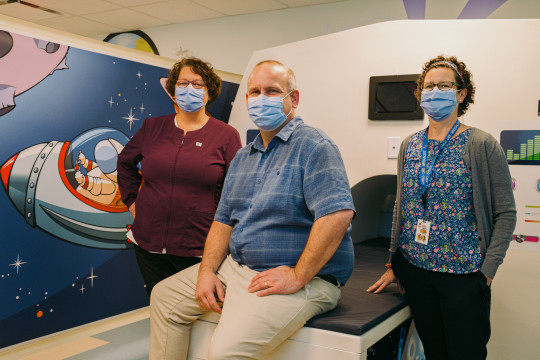A position being trialed in IWK diagnostic imaging (DI) is reducing the number of children that require a general anaesthetic before they undertake a Magnetic Resonance Imaging (MRI) test. In the first four months of the program about 36 children have completed an MRI without general aneasthetic, which would previously been requested with sedation.
MRIs provide clear images of a body’s soft tissues that X-rays are unable to see. Unfortunately, the machines can be frightening to children as they are loud and confining. Children must lie very still while having an MRI, and often, anesthesia is needed for children between three and eight years of age.
Child life specialist Jane Marchildon works closely with MRI technologists and DI nurses to identify patients who may be able to complete the MRI without sedation. Marchildon reaches out to families in advance to provide preparation advice, tips on how to practice for an MRI, and assess if a child can complete the test awake. When the children come in for their MRI, they use a mock simulator in the waiting area to practice and Marchildon coaches them on what to expect.
“This may be a patient’s first experience at the IWK and we are supporting them to reduce stress and anxiety’” says Marchildon. “Fear of the unknown is a huge thing and lots of people don’t know what to expect when having an MRI.”
“Jane uses child friendly explanations in preparation for the test as well as helping them develop coping mechanisms to support them during the procedure,” says Cathy Whitelaw, a registered nurse in the IWK DI Department. “Jane's role in DI is invaluable as these interventions result in improved patient safety and increased departmental efficiency.”
Avoiding sedation not only improves the children’s recovery time and reduces the risks associated with anesthesia; it also means less time in the hospital for families. Parents would not need to take the whole day off work. The child could go back to school. And anesthesiologists would be able to look after other patients.
“Child life is able to take the time to alleviate any anxiety regarding MRI exams and Jane has become a big help in deciding which children will attempt MRI awake and which will need general anesthesia,” says MRI Supervisor Matthew Rogers. “Any time you can avoid general anesthesia it means the patient doesn’t have to fast beforehand, avoids potential side effects of anesthesia and needs no recovery time once the MRI is finished.”
“Ideally as with all Child Life support, our goal is to reduce the stress that comes with healthcare experiences,” says Marchildon. “Completing an MRI gives patients mastery of their healthcare experience and sets them up to confidently complete other tests or procedures if they are needed.”
March is Child Life Month.
